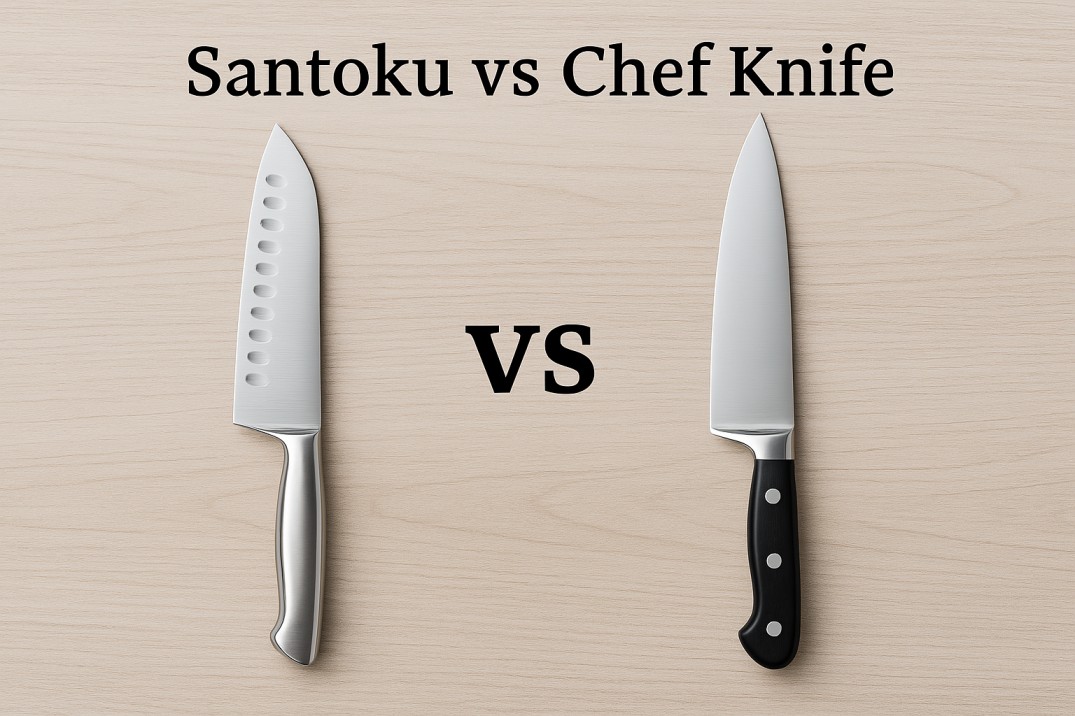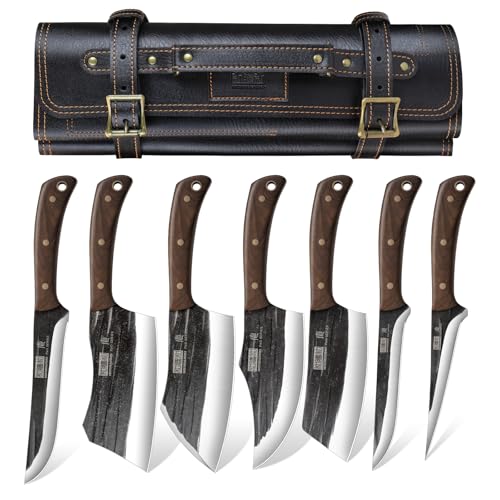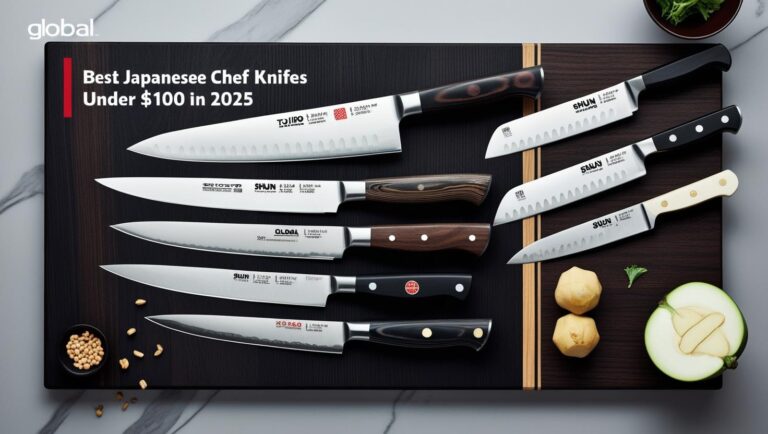Santoku vs Chef Knife: Which One Should You Choose in 2025?
Choosing the right knife can seriously improve your kitchen skills. For many home cooks and chefs alike, it often comes down to two culinary legends: Santoku vs Chef Knife.
At first glance, they may look similar — sharp steel, ergonomic handles, and multipurpose appeal. But look closer, and you’ll discover unique strengths that make each knife a specialist in its own right.
“Give me six hours to chop down a tree, and I will spend the first four sharpening the axe.” — Abraham Lincoln.
Whether you are repping sushi, juliening carrots, or dicing garlic at lightning speed, the knife you hold changes everything. In this guide, we’ll break down the core differences, pros, and cons and help you make the smartest choice for your cooking style.
Let’s slice into it.
HENCKELS 7-Inch Santoku Knife Set – Product Review
Quick Verdict:

The HENCKELS 7-inch Santoku knife delivers exceptional value for everyday cooking. With a sharp, satin-finished blade and a comfortable grip, it’s a great pick for home chefs looking for an affordable yet reliable cutting tool. Lightweight, dishwasher-safe, and backed by a reputable brand, this 2-piece set punches above its price point—especially for those who value ease and convenience over professional-grade weight and heft.
Pros
- Sharp, precise cutting: The fine-edge, stamped blade makes slicing, dicing, and chopping a breeze.
- Ergonomic handle: ABS handle is comfortable, even after extended use.
- Dishwasher-safe: Easy to clean and maintain—ideal for busy kitchens.
- Lightweight: Great for beginners or users with smaller hands.
- Trusted brand: Backed by over 125 years of cutlery expertise from Zwilling J.A. Henckels.
- Excellent value: Budget-friendly without feeling “cheap.”
Cons
- Stamped blade (not forged): It lacks the heavier feel of premium chef’s knives.
- Not for heavy-duty use: It is not ideal for cutting through bones or harder ingredients.
- Limited flex: Some users prefer more versatility for advanced techniques.
- Granton edge missing: Lacks the dimpled edge some Santoku knives offer to prevent food from sticking.
Performance Review
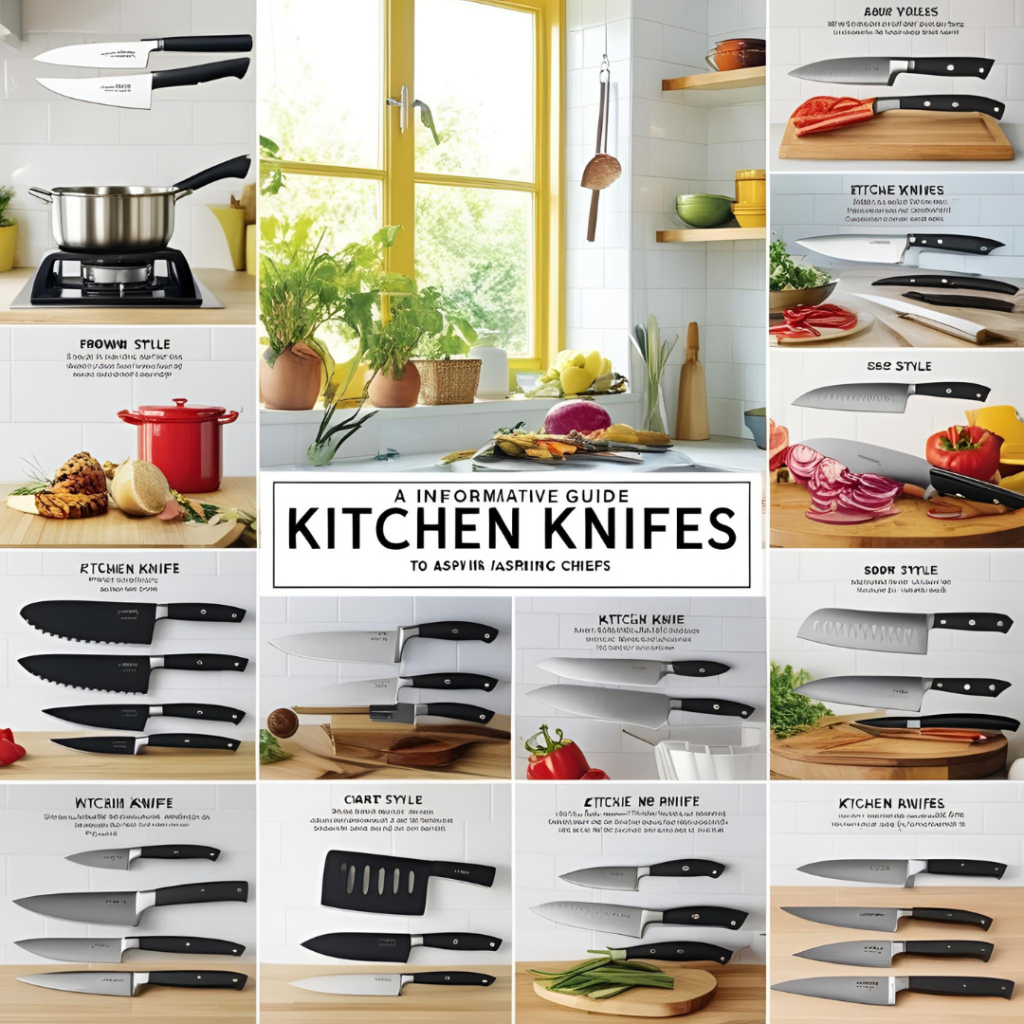
- Vegetable Prep: Performs exceptionally well on onions, peppers, and herbs with quick, clean cuts.
- Meat Handling: Glides through boneless cuts easily, though struggles with tougher proteins.
- Control & Comfort: The handle offers a solid, ergonomic grip, and the lighter weight reduces fatigue.
- Maintenance: Stays sharp for a reasonable amount of time and cleans up easily in the dishwasher.
Customer Feedback Highlights
“Perfect for everyday cooking—I reach for this more than my expensive chef’s knife.”
“Lightweight and super sharp. Great for slicing veggies quickly.”
“I wish it had more heft, but it’s fantastic for the price.”
Best For:
- Home cooks seeking an affordable and dependable knife
- Beginners learning proper knife skills
- Everyday chopping, slicing, and meal prepping.
- Gift sets for new kitchens or first apartments
Why We Recommend It

- Ultra-sharp stainless steel blade – great for effortless slicing and dicing
- Ergonomic, lightweight handle – ideal for everyday use without hand fatigue
- Dishwasher-safe – quick and easy cleanup
- Excellent value – perfect for first-time knife buyers or as a gift set
- From a trusted brand – backed by Henckels, a brand with over 125 years of history
Key Features
| Feature | Details |
| Blade Material | Stainless Steel |
| Blade Length | 7 inches |
| Handle Material | ABS (Acrylonitrile Butadiene Styrene) |
| Construction | Stamped (single piece) |
| Item Weight | 11.3 ounces |
| Dishwasher Safe | Yes |
| Number of Pieces | 2 |
| Made in | India |
| Best Sellers Rank | #2 in Santoku Knives on Amazon |
Use Case Examples
- Everyday veggie chopping (onions, carrots, peppers)
- Slicing boneless chicken, fish, or tofu
- Mincing garlic, herbs, or shallots
- Perfect for meal preppers and home cooks
- Not ideal for cutting bones or large, hard foods like butternut squash
Final Thoughts
The HENCKELS 7-Inch Santoku Knife Set is a solid performer for the home kitchen. While it may not have the craftsmanship of high-end forged knives, it delivers where it counts: clean cuts, easy handling, and reliable performance at a budget-friendly price. If you’re not planning to butcher a whole chicken or carve a roast, this knife could easily become your daily go-to.
What Is a Santoku Knife?
The santoku knife is a Japanese powerhouse. The name “santoku” translates to “three virtues,” referencing its strength in slicing, dicing, and mincing.
- Origin: Japan, designed as a general-purpose kitchen knife.
- Blade shape: Typically 5 to 7 inches, with a flat edge and a rounded, “sheep’s foot” tip.
- Features: Often includes a Granton edge (dimples along the blade) to reduce food sticking.
- Ideal for: Cutting vegetables, fish, and boneless meats with finesse.
- Why it’s loved: Lightweight, well-balanced, and incredibly precise — especially for thin slicing.
When to Use a Santoku Knife
A santoku knife might not be the most common tool in every kitchen. But once you understand what it’s good for, you’ll wonder how you cooked without it. Known for its lightweight precision and speed, the santoku excels in specific scenarios where finesse and control are everything.
This guide will explain when and why to use a santoku knife, how it differs from a chef’s knife, and how to get the most from this Japanese gem. Whether slicing veggies or mastering meal prep, this is your go-to blade for clean, confident cuts.
Let’s get cutting.
What Makes a Santoku Knife Unique?
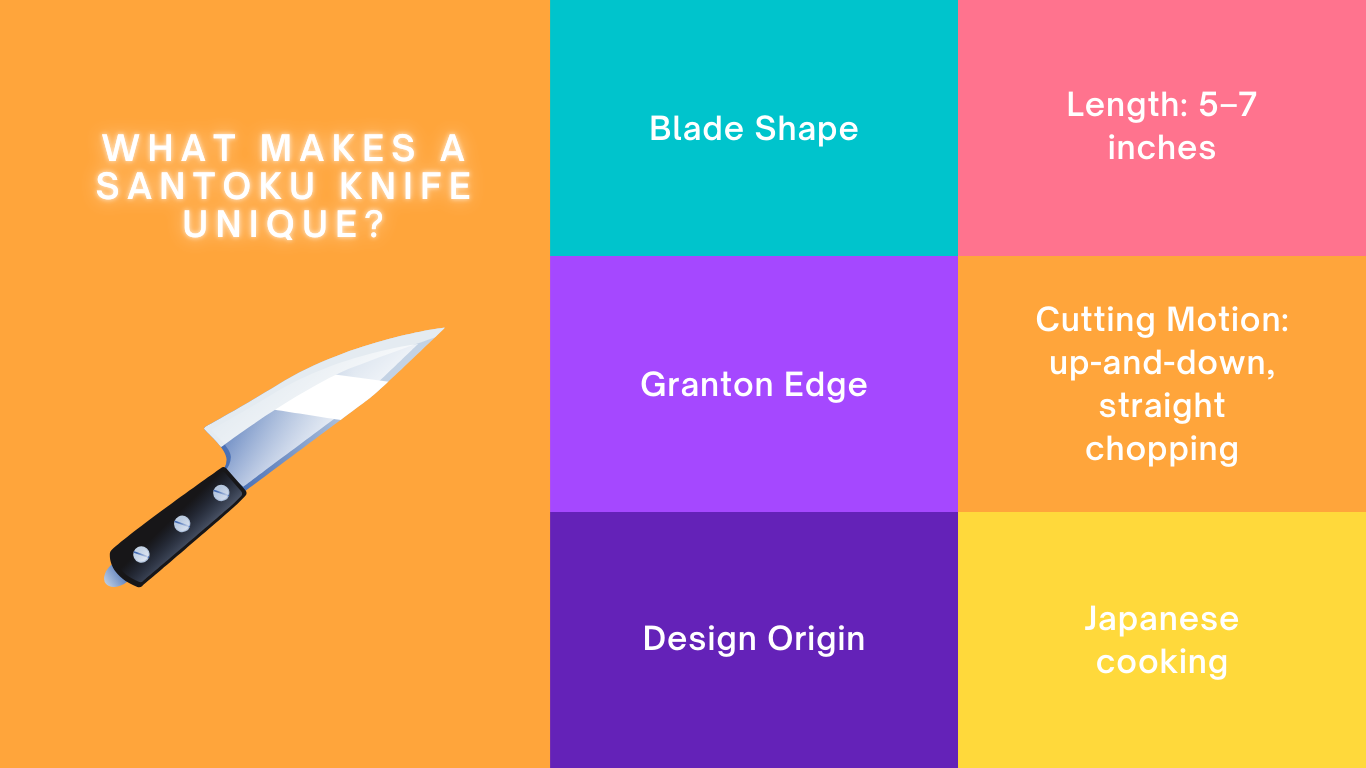
Before we jump into when to use it, let’s quickly understand why the santoku knife is special.
- Blade Shape: Flat edge with a rounded, “sheep’s foot” tip for extra control
- Length: Typically between 5–7 inches — shorter than a chef knife
- Granton Edge: Dimpled indentations help prevent food from sticking
- Cutting Motion: Best used with an up-and-down, straight chopping technique
- Design Origin: Rooted in Japanese cooking, favoring precision over brute force
This makes it ideal for smaller hands and tasks requiring speed and delicacy.
1. Slicing Vegetables with Precision
Santoku knives were practically made for vegetable prep. Their thin blades and light weight make quick work of carrots, zucchini, bell peppers, and onions—especially when you need uniform slices for presentation or cooking.
Use it when making stir-fry, salad, or vegetable platters.
2. Cutting Boneless Meats and Fish
Do you need boneless chicken, fish fillets, or pork tenderloin? The santoku knife handles them with elegance. While unsuited for bone cutting, its sharp edge glides easily through soft proteins.
Use it when: Prepping sashimi, cubing chicken breast, or slicing cooked meats.
3. Mincing Garlic, Herbs, or Onions
The flat edge of a santoku knife is perfect for mincing, mainly when used with a straight-down chopping motion. It also prevents your ingredients from sliding around, a common issue with curved blades.
Use it when making pesto, preparing garlic for sautéing, or chopping fresh cilantro.
4. Meal Prepping and Speed Tasks
If you’re a meal-prep fanatic, the santoku is your MVP. The shorter blade offers more control and less fatigue, so you can slice through piles of ingredients without missing a beat.
Use it when: Prepping multiple ingredients in one session.
5. Sliced Cheese and Soft Produce
Thanks to the Granton edge, the santoku is excellent for slicing through sticky or soft items. It helps prevent cheese or avocado from clinging to the blade, giving you clean, consistent slices.
Use it when: Slicing mozzarella, brie, or ripe tomatoes.
When NOT to Use a Santoku Knife
While santoku knives are versatile, there are a few times when you should reach for a different blade:
- Cutting through bones (opt for a cleaver or chef knife)
- Heavy-duty chopping (like squash or watermelon)
- Tasks requiring a rocking motion (better with a chef knife)
Tips for Using Your Santoku Knife
- Use a straight chopping motion. Avoid rocking like with a chef knife.
- Keep it razor-sharp. The thin blade needs consistent honing for top performance.
- Mind your grip. Hold the handle firmly, guiding with your fingertips for precision.
- Use a wooden or plastic cutting board. It protects the blade and your counter.
- Hand wash only. Keep it out of the dishwasher to preserve the edge and handle.
So, when should you use a santoku knife? Anytime precision, speed, and finesse are the goals. Whether you’re meal-prepping like a boss or crafting Instagram-worthy veggie platters, the santoku knife shines when the task calls for clean cuts and control.
While it might not replace your chef knife entirely, it deserves a spot on your kitchen counter — especially if you love slicing, dicing, and prepping like a pro.
Ready to slice smarter, not harder? Grab your santoku and make your next meal a cut above the rest.
What Is a Chef’s Knife?
The chef knife, a cook’s knife, is a staple in Western kitchens. If you’ve ever watched a cooking show or seen a professional chef in action, chances are they were wielding one.
- Origin: Europe, particularly France and Germany.
- Blade design: Curved belly with a sharp tip, usually 8 to 10 inches long.
- Function: It is esigned for a rocking motion to chop, slice, and mince easily.
- Strengths: Durable, powerful, and incredibly versatile for any kitchen task.
Key Differences Between Santoku vs Chef Knife
Let’s go blade to blade on the key differentiators:
| Feature | Santoku Knife | MOSFiATA 8″ Chef Knife |
| Blade Length | Typically 5-7 inches | 8 inches |
| Blade Material | Often, high-carbon stainless steel or ceramic | High-carbon German EN1.4116 stainless steel |
| Handle Material | Varies (e.g., wood, plastic, steel) | Micarta with textured finger points for a non-slip grip |
| Blade Shape | Flat with a slight curve, often with a rounded tip | Curved, standard chef knife shape for general chopping |
| Blade Edge | Straight edge with a flat cutting profile | Razor-sharp edge, hand-sharpened at 16° per side |
| Design Type | Traditional Japanese style blade with a broader blade | Complete tang construction with ergonomic design for comfort |
| Functionality | Best for slicing, dicing, and mincing; versatile in Asian cuisine | Best for slicing, chopping, dicing, and mincing; versatile for all tasks |
| Best For | Precision cuts for vegetables, fish, and meats | Heavy-duty tasks, meat, vegetables, and general kitchen tasks |
| Corrosion Resistance | Varies by brand; typically stainless steel for resistance | 15% chrome for anti-corrosion, anti-tarnish finish |
| Sharpness | Very sharp, but requires regular honing | Ultra-sharp, remains sharp even with heavy use |
| Dishwasher Safe | Depending on the model, some are not | Yes, top-rack dishwasher safe |
| Included Accessories | Often comes alone; accessories sold separately | Comes with a knife sharpener, finger guard, and blade guard |
| Customer Rating | Varies by brand, typically 4-4.5 stars | 4.6 stars (10,319 ratings) |
| Price Range | Mid-range to high-end, varies widely | $25.99 (typically $39.99) |
| Ideal Use | Great for precision and general-purpose kitchen tasks | Best for chefs looking for a multipurpose, durable, sharp knife |
Feature Santoku vs Chef Knife
| Feature | Santoku Knife | Chef Knife |
| Blade Shape | Flat edge, sheep’s foot tip | Curved edge, pointed tip |
| Length | Shorter (5–7 inches) | Longer (8–10 inches) |
| Cutting Style | Up-and-down, straight cuts | Rocking motion |
| Weight & Balance | Lighter, better for small hands | Heavier, more forceful |
| Best For | Veggies, fish, fine slicing | Meat, hard veggies, general tasks |
| Sharpening Angle | 12–15 degrees | 15–20 degrees |
Pros and Cons of Chef Knives
Pros
- Extremely versatile — a true all-rounder
- Better suited for large or dense items
- Excellent for “rock chop” techniques
- Available in many lengths and materials
Cons
- Heavier — may cause fatigue over time
- Less precision for thin slicing
- Bulkier for smaller hands or short tasks
Which Knife Should You Choose?

Here’s the million-dollar question: Which knife belongs in your kitchen?
Consider these factors:
- Your cooking style: If you prefer fine slicing, vegetables, or seafood, go with the santoku. The Chelikee shines if you are interested in eating, including meats and bulk prep.
- Hand size and comfort: Smaller hands often prefer the lighter, nimble santoku.
- Cuisine: Japanese cuisine fans might favor santoku; Western food lovers may benefit more from a chef knife.
- Skill level: Both are beginner-friendly, but the chef knife has a steeper learning curve due to its size and weight.
- Budget and material: Both come in premium and budget versions. Choose high-carbon steel for edge retention and durability.
Pro tip: If you can afford both, do it. Many chefs keep both in rotation and switch based on the task.
Expert Tips on Buying the Right Knife
- Test the weight: A knife should feel like a natural extension of your hand.
- Check the balance: Hold the knife at the bolster (where the blade meets the handle). A well-balanced knife will not tip forward or back.
- Blade material matters: High-carbon steel keeps a sharp edge longer, but stainless steel is rust-resistant and easier to maintain.
- Handle comfort: Wood, plastic, or composite — try before you buy.
- Trusted brands (2025): Shun, MAC, Wüsthof, Global, Victorinox, Miyabi.
Conclusion
Choosing between a santoku and a chef’s knife doesn’t have to be a cutthroat decision. Both are exceptional tools, tailored to different culinary personalities and tasks. The key is knowing how you cook and picking the knife that complements your rhythm in the kitchen.
So, are you team precision or team power? Either way, the right blade in your hand means smoother prep, faster results, and dishes that taste (and look) like they came from a pro.
Ready to upgrade your kitchen game? Start by investing in the right knife — your fingers will thank you.

